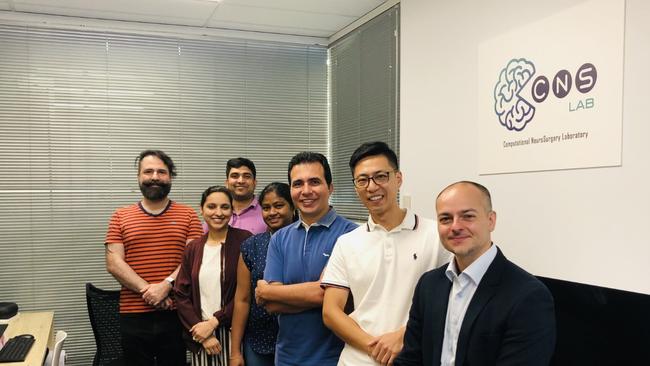Brain cancer treatments to be revolutionised with artificial intelligence
Australian researchers are pioneering the use of artificial intelligence to speed up the diagnosis and treatment of some types of brain cancer.

The treatment and diagnosis of brain cancer is being revolutionised by Australian researchers using artificial intelligence to take more accurate images of the brain, in the hopes it will speed up diagnosis and eliminate unnecessary surgery.
Royal Australian College of Surgeons fellow Antonio Di Ieva and his team at Sydney’s Macquarie University are the first in the country to use the technology and a magnetic resonance technique called 2HG-Magnetic Resonance Spectroscopy.
The technologies analyse surgical samples and identify a genetic mutation that allows doctors to confirm the diagnosis of the type of glioma — the most common primary brain tumours.
The mutation, which can be identified only by performing a brain tumour biopsy, allows doctors to determine whether a patient has “long or short” survival prospects.
An artificial intelligence method called “deep learning” has been trialled by Professor Di Ieva to analyse surgical samples of glioblastomas to detect whether the genetic mutation is present before surgery and without pathological analysis.
“We were the first in Australia to introduce magnetic resonance spectroscopy (a scan that identifies chemical changes in the brain) to predict if the mutation is there,” he said. “Instead of a routine two or three weeks it takes for a pathologist to tell us if the mutation is there, we just take a picture of the sample and we have trained our model with a technique called deep learning in order to know if the mutation is present,” he said.
A pathologist typically diagnoses the “grade” of the brain tumour, and other specialists work together to determine how to treat it with radiation or chemotherapy.
Today we run the first official meeting of the Computational NeuroSurgery (CNS) Lab @Macquarie_Uni . Great brainstorming, several projects, beautiful minds. Revolution in the clinical neurosciences and machine vision in progress, stay tuned! pic.twitter.com/sqpdpyfgIu
— Antonio Di Ieva (@antonio_ieva) September 29, 2020
Sometimes invasive treatment methods are not needed because tumours can be misdiagnosed, Professor Di Ieva said. “Despite … the decision-making, we will go to biopsy or operate on the patient (when) they don’t need surgery because they needed a different treatment,” he said. “The way to fix this problem is by applying artificial intelligence to improve the diagnostic power and decision-making for these patients.”
The AI method is being trained to “extract pictures from an image” to recognise patterns that will tell specialists whether a patient has a brain tumour and whether it is a glioblastoma.
Use of AI should ultimately enhance the work of specialists, not replace them, he said.
Trials are in progress worldwide to use the mutation — the IDH gene — as a target for specific vaccines, opening new avenues in the treatment of brain cancer. Brain tumours typically don’t spread but glioblastomas are the most malignant and can move into other parts of the brain or spinal cord.
Professor Di Ieva’s team is also the first in the world to harness an AI technique called Generative Adversarial Network to synthesise and create fake images of tumours — in the same way “deep fake” images are created of people.
It allows computers to be trained faster than a pathologist, who would require several years of training to reach the same level of expertise.





